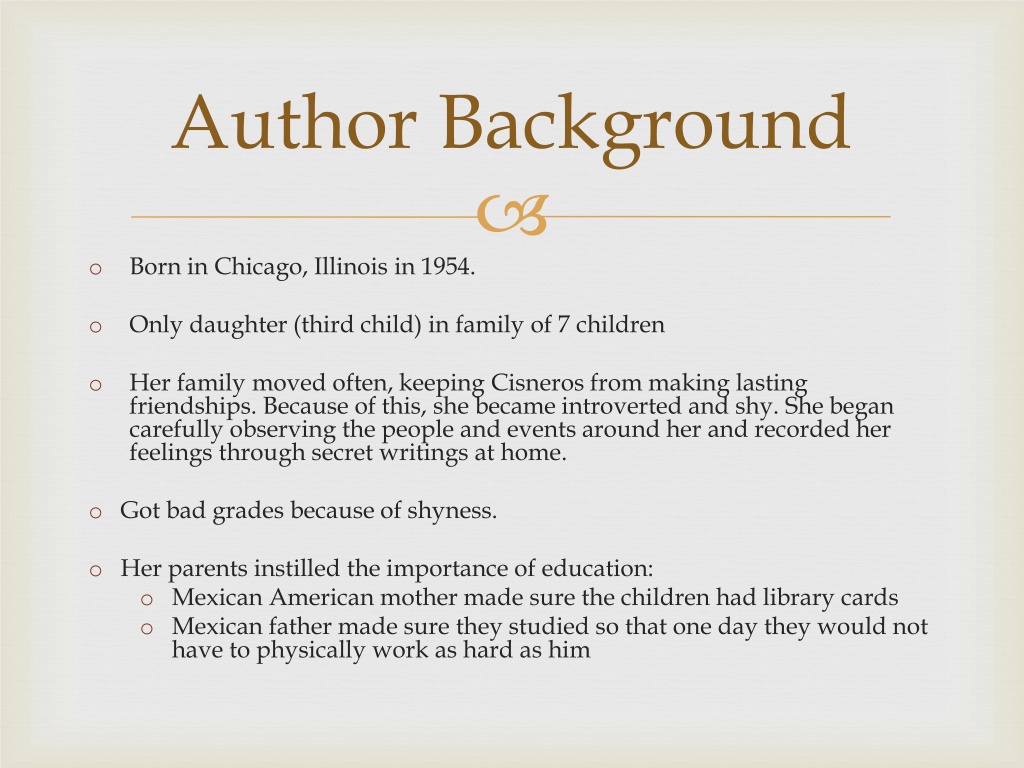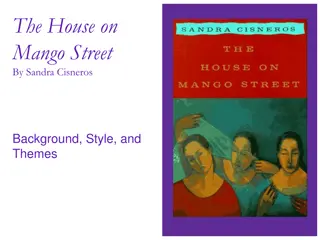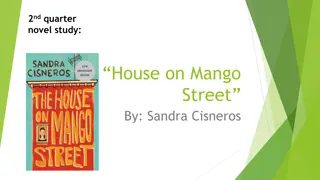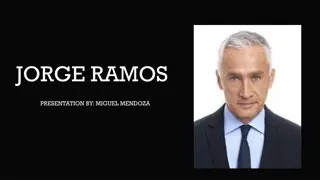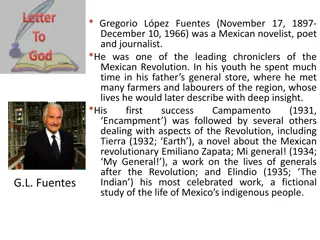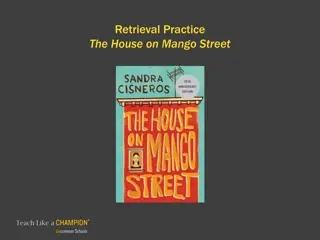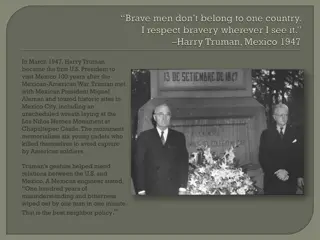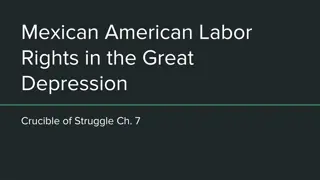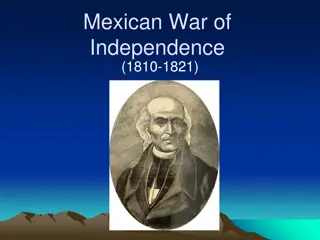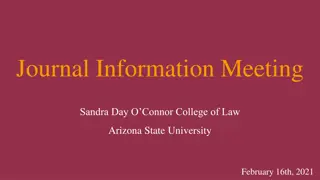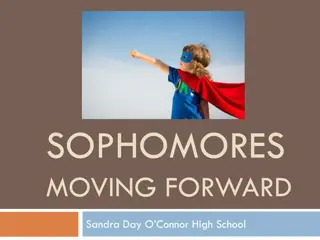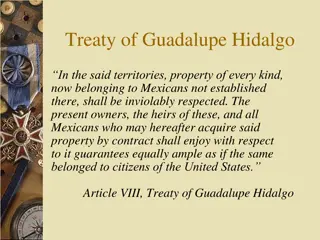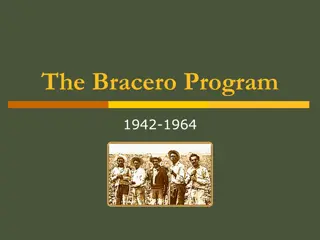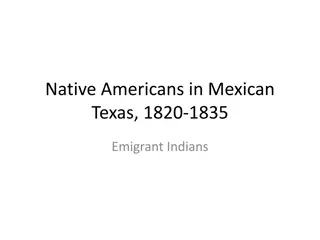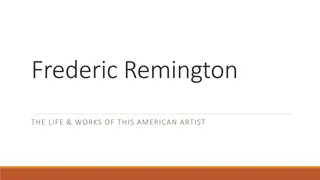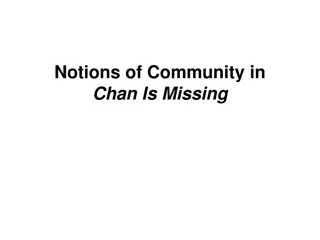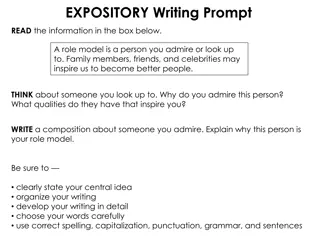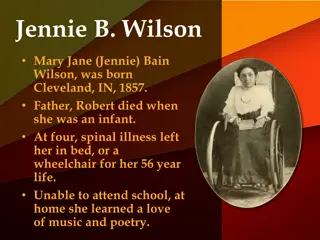The Inspiring Journey of Sandra Cisneros: A Mexican-American Author
Sandra Cisneros, born in Chicago in 1954, overcame shyness to become a celebrated author, known for works like "The House on Mango Street." Drawing from her dual Mexican-American heritage, she sheds light on the immigrant experience in the United States. Despite facing challenges, Cisneros found her unique voice and has made significant contributions to literature and education, advocating for social issues through her writing and foundation work.
Download Presentation

Please find below an Image/Link to download the presentation.
The content on the website is provided AS IS for your information and personal use only. It may not be sold, licensed, or shared on other websites without obtaining consent from the author. Download presentation by click this link. If you encounter any issues during the download, it is possible that the publisher has removed the file from their server.
E N D
Presentation Transcript
Author Background Born in Chicago, Illinois in 1954. o Only daughter (third child) in family of 7 children o Her family moved often, keeping Cisneros from making lasting friendships. Because of this, she became introverted and shy. She began carefully observing the people and events around her and recorded her feelings through secret writings at home. o o Got bad grades because of shyness. o Her parents instilled the importance of education: o Mexican American mother made sure the children had library cards o Mexican father made sure they studied so that one day they would not have to physically work as hard as him
AB #2 o Encouraged to share writing in 10th grade. o Cisneros wrote about Mexican/Mexican American women who find strength to rise above the poor conditions of their lives. o She earned a BA in English from Loyola University of Chicago in 1976. However, it wasn't until working on her master's degree at the University of Iowa Writers Workshop in the late 1970's that she says she found her particular voice, as a working-class, Mexican-American woman with an independent sexuality. The experience of recognizing her difference from other students at Iowa eventually led to the writing of The House on Mango Street, which was published by Arte Publico Press of Houston in 1984 and won the Before Columbus Foundation's American Book Award in in 1985.
AB #3 o I've worked as a teacher and counselor to high-school dropouts, as an artist in the schools where I taught creative writing at every level except first grade and pre-school, a college recruiter, an arts administrator, and as a visiting writer at a number of universities." (Taken from her website.) o Attended Iowa s Writers Workshop (VERY prestigious) o Recipient of the MacArthur Fellowship o First Chicana to sign major publishing contract (with Random House). o Cisneros is the founder and president of the Macondo Foundation, which provides socially conscious workshops for writers, and the Alfredo Cisneros del Moral Foundation, which awards talented writers connect to Texas (Cisneros). Cisneros has been a teacher, a college recruiter, a counselor, an artist-in-the school and taught creative writing, and a visiting writer at numerous universities. She truly cares about the issues her works address and has earned her place in the American Cannon.
Historical Links 1. Cisneros plays on her dual Mexican American heritage throughout her work, and The House on Mango Street in particular reflects the experience of Mexicans in the United States. In the midnineteenth century, Mexico ceded its northern territories (present- day California, Arizona, and New Mexico) to the United States at the end of the Mexican War, and Mexican landowners lost many of their rights under the Treaty of Guadalupe Hidalgo. From about 1900 to 1920, immigrants from Mexico were actively recruited into the United States as low-cost labor for railroad, mining, and other industries, especially throughout the southwestern United States. Mexican immigration was widespread and unregulated through the 1920s, when immigration from Mexico and some other countries hit its peak. Between World War I and World War II, however, Mexican immigration came to a halt due in part to the pressures of the Great Depression, and Mexican Americans faced repatriation, poverty, and rampant discrimination.
2. Despite their contribution and service to the U.S. Army during World War II, Mexican Americans continued to face discrimination upon returning home after World War II. For example, many Mexican Americans were treated like second-class citizens. And throughout the fifties and sixties, despite their eagerness to integrate more fully into American society, Mexican Americans were still treated as "outsiders" by mainstream American culture. Despite their push for civil rights throughout the 1960s and the 1970s, many Chicanos still faced discrimination that limited opportunities for advancement. By 1983, when The House on Mango Street was published, stringent U.S. immigration laws had long limited the number of Mexicans who were allowed to immigrate to the United States. Those who had immigrated legally or been born in America still experienced stereotyping and biases in American culture at large. In "Those Who Don't," Cisneros evokes the stereotyping of Mexican Americans: "Those who don't know any better come into our neighborhood scared. They think we're dangerous. They think we will attack them with shiny knives."
3. Because of the discrimination often leveled at Spanish-speaking populations by English-speaking Americans, many Mexican Americans choose to resist speaking Spanish except among family within the privacy of their homes. Cisneros, for example, remembers that she only spoke Spanish with her father at home, while otherwise being fully integrated within the mainstream American educational system. On the other hand, other Mexican Americans, particularly those of the older generations who retained a nostalgia for their mother country, never relinquished the use of Spanish as their primary tongue. In The House on Mango Street, for example, Mamacita consciously refused to speak English because for her it represented a blatant rejection of her past and her identity, and she limited her English vocabulary to "He not here," "No speak English," and "Holy smokes." Esperanza's father remembers eating nothing but "hamandeggs" when he first arrived in the United States because it was the only English phrase he knew. In the United States today, there is a renewed interest among the younger generation of Mexican Americans to learn and more fully appreciate the Spanish language.
4. The largest number of Mexican Americans in the United States are concentrated in southern California and Texas, with another sizable population in New York City. As one of the largest cities in the United States, Chicago historically has also attracted immigrants from around the world, including those from Mexico. Cisneros and her mother were born in the United States, as are many of the characters in The House on Mango Street. Nevertheless, they retain strong ties with their Mexican heritage and are integrated into the Mexican American communities throughout the country. In different parts of the country, these groups are referred to as "Mexican American," "Mexicanos," "Chicanos," and sometimes by the more general terms "Hispanics" or "Latinos," which collectively describes people from those cultures colonized by Spain from the fifteenth century to the present, including Cuba, Puerto Rico, Mexico, and many other countries. The population of Hispanics in the United States continues to swell, and by some estimates, they will make up about thirteen percent of the nation's population by the early years of the twenty-first century.
5. Historically, Mexican American men and women have suffered negative stereotyping and prejudices that prevented them from securing desirable jobs and being upwardly mobile within the society. Therefore, many remain concentrated in low-income neighborhoods like the one portrayed in The House on Mango Street. Poverty is a reality faced by many Mexican American populations living in the United States. In The House on Mango Street, the theme of poverty pervades the stories. In "Alicia Who Sees Mice," for example, the mice are a symbol of poverty. Alicia, who stays up late studying because she "doesn't want to spend her whole life in a factory or behind a rolling pin," sees the mice scurrying around after dark, a symbol of her circumstances in the neighborhood. In The House on Mango Street, the source of Esperanza's embarrassment about her house and her circumstances derives from the poverty that many Mexican Americans face. In "Bums in the Attic," the economic disparity between "people who live on hills" and those who live in the barrio is clear.
6. The role of women within the history of the Hispanic community is significant. Although in The House on Mango Street and other works by Cisneros, some Mexican American women are portrayed as trapped within a cycle of socialization, Cisneros noted in a 1992 interview in Interviews with Writers of the Post-Colonial World, "I have to say that the traditional role is kind of a myth. The traditional Mexican woman is a fierce woman. There's a lot of victimization but we are also fierce. We are very fierce." throughout high school, and she remembers reading works such as Lewis Carroll's Alice's Adventures in Wonderland. But only when she was introduced to the Chicago writing scene in college and graduate school did Cisneros come in contact with Chicano writers. Later, Chicano writers like Gary Soto, Loma Dee Cervantes, and Alberto R os were also among her circle of colleagues. Today, Sandra Cisneros stands foremost among Chicana writers who emerged in the 1980s, including Ana Castillo, Denise Ch vez, and Gloria Anzald a. Cisneros says she was influenced by American and British writers
Consider This What is racism? What is racial discrimination? What are the rights of the child? What are women rights? What is a Human Right and who determines when a right is applicable?
Consider This What is racism? What is racial discrimination? What are the rights of the child? What are women rights? What is a Human Right and who determines when a right is applicable?
